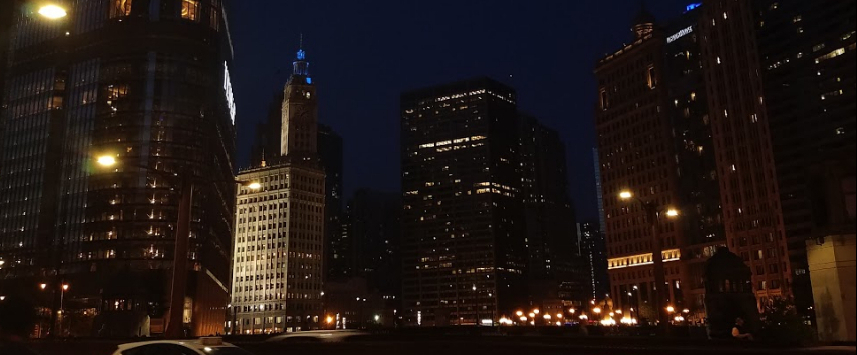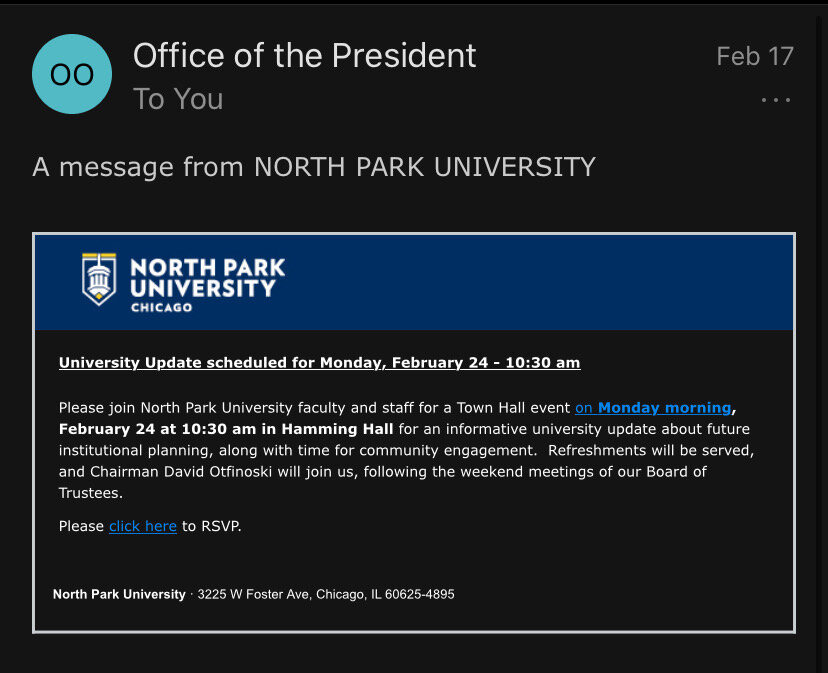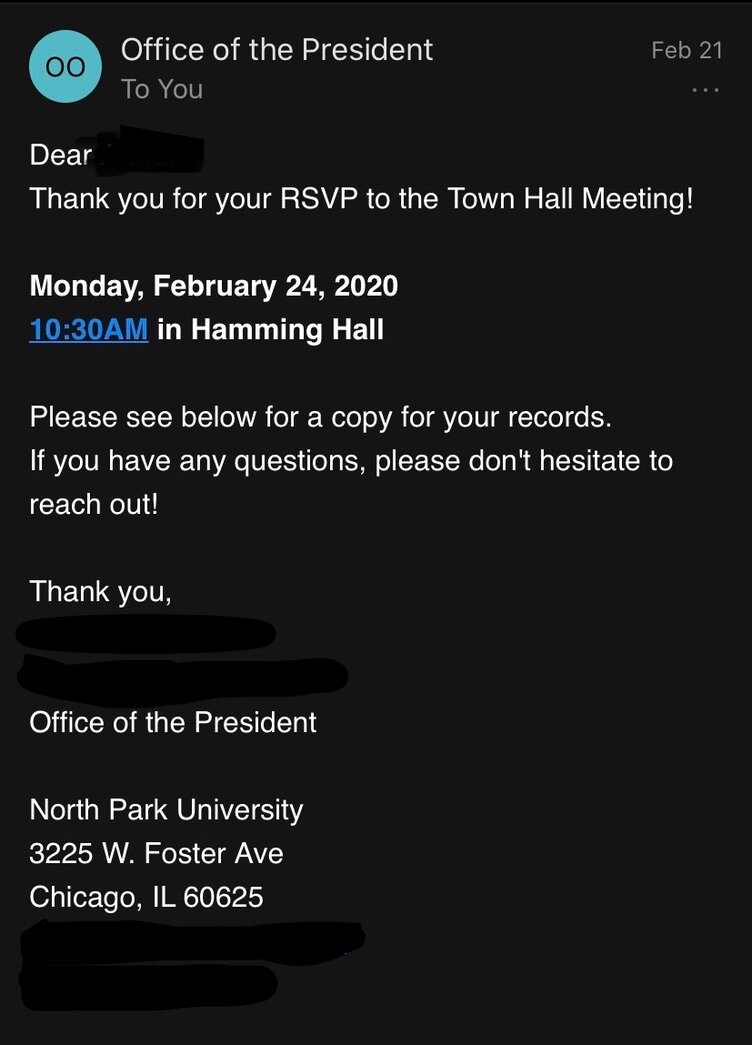Let Them Speak: A North Park Town Hall
On February 24th over fifty students marched in a single file line from Einstein’s Cafe to Hamming Hall to attend a town hall meeting about the future direction of North Park and to ostensibly hear from the voice of the campus community. This meeting would turn contentious upon their entrance and with their insistence on being heard. It would become more contentious when faculty members interrupted the outside presenter, and respectfully asked to hear directly from President Surridge.*
The students, led by student leaders Daniel Strom, president of the student government, and Fridz Frezar, entered quietly and began to line the east wall of the building, anxiously awaiting a time to share the concerns about being overlooked as stakeholders in the university. The students entered under the assumption that they had been invited to the town hall via an email to “join the faculty and staff.” They welcomed this as the long-awaited opportunity to articulate their specific concerns and to hear about the future of the school. When they RSVP’d to the email, the invitation was rescinded, leaving the students to believe that they had been stonewalled again by the administration. As a result, the students began to organize their strategy. We have included, below, screenshots of the emails sent to students from the Office of the President informing them that they were not invited to the town hall event but have decided to blur out the names of both the recipients and senders.
Within the weekend, students and student leaders alike began to devise a plan for action, going to social media platforms and word-of-mouth invitations to fellow students to join their student leaders in a march from Einstein’s Café to Hamming Hall in solidarity. As they marched silently and began to line the walls of Hamming Hall, President Surridge graciously welcomed these unexpected guests and invited them to find seats. With solidarity to one another at the forefront of their minds and with no empty chairs in sight, they continued to stand awaiting the question and answer portion of the event that characterizes most town hall meetings. Both student leaders, Daniel and Fridz, had prepared statements to transmit their grievances and concerns with the administration, as well as their hopes for including students in planning for the future.
As the presenter from Gray Associates, the company hired to assist in institutional planning, pressed on with his presentation regarding “North Park Next” the time for the community to voice its concerns was dwindling down. The students began to fear that their voices would again be stifled, as they were back in November during the campaign of United North Park. When a PowerPoint slide announced the university stakeholders as faculty and staff but failed to mention students, Daniel and Fridz decided it was time to ask permission to speak. As the student leaders moved toward the front, several faculty and staff members began to rise from their seats to stand side-by-side with the students at the same moment that administrators stood up and stepped between the student leaders and president of the university.
As Daniel and Fridz repeatedly and respectfully asked for a moment to speak, the president affirmed that she valued student voices and encouraged them to use the regular channels of communication already in place. Voices from the audience began to erupt shouting, “let him speak,” and “this is a town hall.” At this point, the president handed the microphone over to Daniel, who would subsequently hand it to Fridz, and they began to address the concerns of the students inside and outside of the crowded room. Daniel made clear that students are the primary stakeholders of the university and deserve a significant voice in the university, “we [the students] are the reason the school exists; we keep the lights on.” The applause that burst forward from the audience showcased they were not alone in their beliefs. Daniel and Fridz continued, addressing issues such as the safety of faculty, staff, and students; a lack of transparency from administration to the students; a high turnover rate of employees; and the lack of student voices in decision-making. A video of the student-interruption, taken from the Facebook page of the student government association, is listed below, and you can find the entire speech that Daniel Strom intended to give, but rather shared a portion of, here.
After the students concluded their interruption (which would last only four minutes), President Surridge lauded the students and charged the audience--addressing the faculty, staff, and board members present—stating that “this is why we need to be around, this is why we need to strengthen ourselves.” The students then began to march out as quietly as they marched in. As the presentation moved to the final question and answer portion, the outside presenter himself acknowledged that he “knows more about the University now [after the actions taken by students] than he did an hour ago,” a statement that, perhaps, indicates a win for the students—their voices were heard—and he began to take questions from the faculty, staff, and a few students who remained.
Some questions addressed the healing of the campus community, such as that asked by faculty member Dr. St. Jean. While other questions, such as that asked by Dr. Arnesen, questioned what creative solutions would be employed in the logistical steps of North Park Next. Staff member, Sharee Myricks, Director of the Office of Diversity, would question whether or not the university would create opportunities for dialogue before the process by Gray Associates would be finished. Nearing the end of the event, shouting erupted again from the back of the room asking for President Surridge to speak in place of the outside presenter. Audience members joined the call for the president to speak directly to the community. President Surridge then took over the microphone and addressed the audience. You can hear her speech near the end of our second linked recording (found below), around the twenty-minute mark, where she pointed to the environment of the now, the environment of the future, and the environment of higher education in general, as well as a myriad of other points related to these concepts.
If you weren’t there but are interested in learning more about the logistics of the North Park Next campaign, listen to the audio recordings** below taken during the event. Please stay tuned for a post coming this Friday where we gather reflections, comments, and statements from students, faculty, and staff regarding the events at the town hall. We will also include this article (as well as the one to follow) in our final print edition of the year, which will encompass the themes of resistance and metamorphosis. We invite your letters to the editor to create our own version of a town hall, accepting your questions, comments, thoughts, and reactions! Let us know what you, the students, think.
*We must note that while Vista tries to be balanced and give space to both sides of the issue at hand, we are first and foremost a student-based publication and therefore take on a student point-of-view in our commentary and further acknowledge that our coverage does not live in an issue-free vacuum. We are students and these issues impact us as well.
**We understand that the recordings are missing a total of five-ten minutes at the beginning, and roughly three minutes in the middle where Dr. Peter St. Jean was introducing himself. However, we feel the recordings adequately and accurately represent the proceedings to the best of our ability.









